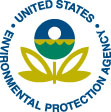
 |
Cost and Performance
Report:
|
Back to Site Information | Table of Contents | Forward to Treatment System Description
Type of Matrix processed through the treatment system: Soil (in situ)
Primary Contaminant Group: Halogentated Volatile Organic Compounds
The primary contaminant identified in the soil at the Well Number 3 Subsite was carbon tetrachloride (CCl4). Other contaminants identified at the site included chloroform, trichloroethene (TCE), 1,1-dichloroethane (DCA), 1,1,1-trichloroethane (TCA), and tetrachloroethene (PCA).
The results of soil gas surveys conducted by EPA at the site and shown in Figure 3, indicate that the highest CCl4 concentration measured in the soil gas was 1,234 parts per million volume (ppmv) at 112 feet below the ground surface. In addition, CCl4 concentrations were highest at depths of greater than 40 feet below ground surface. [1, 2]

Figure 3. Soil Gas Concentrations [1]
The major matrix characteristics affecting cost or performance for this technology and their measured values are presented in Table 1. A particle size distribution as determined by the Unified Soil Classification System (USCS) for soils at 20 and 100 feet below ground surface (BGS) is shown in Table 2.
Table 1. Matrix Characteristics [4]
| Matrix Characteristic | Value |
Measurement Method |
|---|---|---|
| Soil Classification | Not Available |
-- |
| Particle Size Distribution | See Table 2 |
Unified Soil Classification System (USCS) |
| Moisture Content* | 26.3% at 20 feet BGS |
Not Available
|
| Air Permeability | 1.9 x 10 cm² |
Gas Tracer Test |
| Porosity | Not Available |
-- |
| Total Organic Carbon* | 270 mg/kg at 20 feet BGS |
Not Available |
| Nonaqueous Phase Liquids | Not Available |
-- |
| Depth to Groundwater | 125 feet BGS |
Field Measurement |
| Depth of Contamination | 125 feet BGS |
Field Measurement |
*Moisture Content and Total Organic Carbon results are
from samples collected from soil boring of extraction well SVE-1D.
**"Shallow zone" is defined as 0-65 feet BGS; the "deep
zone" is defined as >65 feet BGS.
Table 2. Particle Size Distribution of
Soil Samples
from the Hastings Well Number 3 Subsite [4]
| Soil Type | Depth | |
|---|---|---|
| 20 Feet BGS | 100 Feet BGS | |
| Gravel | 0.00% | 0.00% |
| Corase Sand | 0.10% | 9.30% |
| Medium Sand | 0.00% | 8.60% |
| Fine Sand | 1.50% | 51.80% |
| Very Fine Sand | 2.00% | 23.40% |
| Silt | 73.70% | 6.90% |
| Clay | 22.60% | 0.035% |
Site Geology/Stratigraphy
The Hastings site is underlain by two distinct
fluvial lithologies consisting of unconsolidated sands, silts, and gravels of
the Pleistocene and Pleistocene/Miocene ages. The upper fluvial unit consists
of a poorly-graded fine sand to silty clay sand while the lower fluvial unit
consists of well-graded medium to coarse gravelly sand. The water table is
situated in the lower unit at a depth of approximately 125 feet below ground
surface. A stratigraphic cross section of the site is presented in Figure 4.
[3,
4]

Figure 4. Stratigraphic Cross Section [4]
Back to Site Information | Table of Contents | Forward to Treatment System Description